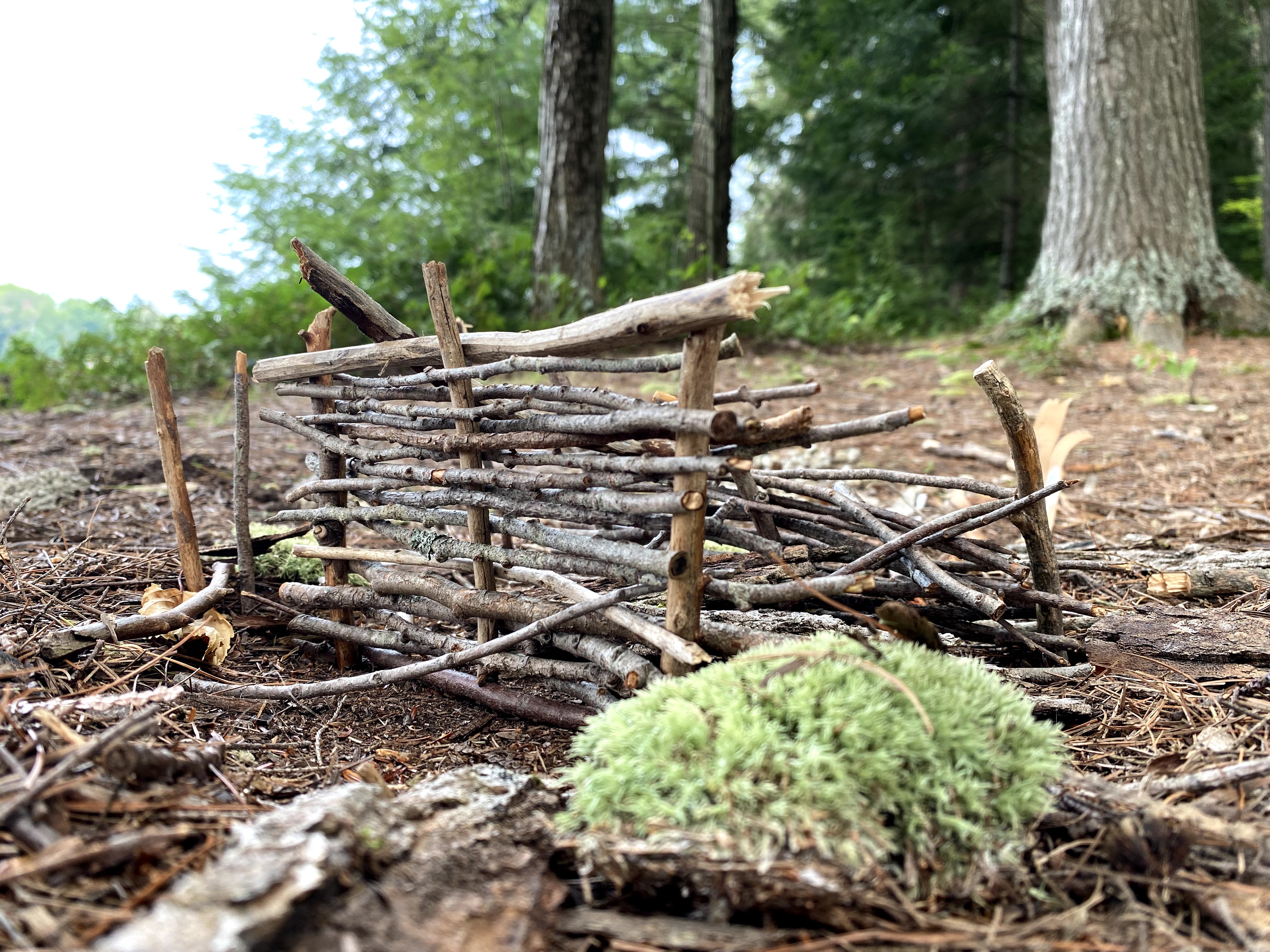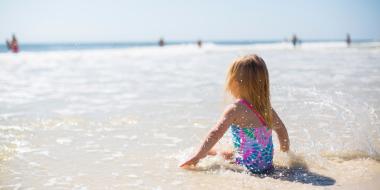“Play gives children a chance to practice what they are learning.” - Mr. Rogers
Children easily see the beauty and wonder in nature. They stop to meander by the stream and pick up a stick; maybe they examine it, or bang it on the ground a few times. It could then become a sword, a walking stick, or a writing tool. Perhaps they will walk with it for a brief time, making marks as they go. If the stick is worthy, it may make it home, but it could also be easily tossed into the water and witnessed as it travels downstream.
Outdoor play and raw materials are open-ended invitations for children to create. In this time of quarantines, online learning, illness, and uncertainty, free and open-ended creative play is so important, and is a healing process for children big and small. When we play together, we allow children the space to explore what can be intense themes in their lives in a safe way. I love to incorporate artistic experiences and invitations to play and create when working alongside children as an early childhood educator (ECE) and with my own girls.
What is Outdoor Art and Exploration Play?
Just like it sounds, exploration play is an opportunity for creative expression that incorporates play with natural materials, usually outside. This can be in your backyard, a municipal green space in your community, a local park, or a forest. The setting will influence what materials may be found and what you may wish to bring along. This invitation can be as elaborate as adorning large branches or leaves with paint, or as simple as offering a paint brush and water for water painting on the sidewalk. By offering an “invitation” to create, play, and explore materials and settings, we allow children's intrinsic motivation to take over. How they get involved is up to them, and they can then feel empowered and more creative.
Why is outdoor art and exploration play important?
When we shift play and art into nature, children have a different experience. They can use all their senses as a means of connecting and engaging with the natural world. In many cases children are calmer and more at ease when in nature, and also when offered open-ended creative materials (as opposed to finished products to try to recreate). Many times, when we work with children outside, we see them explore the materials in a way they wouldn't if they were indoors. This may be because when we are in nature, we feel a greater sense of freedom, and more at ease. Our senses are awakened. Most importantly, children need experiences in nature to encourage their understanding of conservation through their appreciation of their natural environment.
Outdoor Art for Every Age!
Here are some of my favourite child- and family-approved invitations to play. It is important to acknowledge that many green spaces are not easily accessible to all—something we can discuss with our children while we work. As such, I hope that these activities can provide opportunities for everyone. Many of these experiences can also be adapted to suit all abilities.
Magic Paint: Water Painting with Toddlers and Preschoolers
This is a very easy (and possibly very wet!) activity—excellent for these heat waves we are experiencing! I call this activity “Magic Paint.” See where your child gravitates to use the “magic paint” and watch what happens as it dries.
For this invitation you need:
- an upcycled container
- paintbrushes (various sizes) or make your own from natural materials too!
- water
- “paintable” surface (i.e. sidewalk, large rock, fence)
Water play is a multi-sensory experience, and this activity allows children to explore the causes and effects of water. Include observations, such as noticing with your child when evaporation occurs. Ask questions with them about where the “paint” has gone and why.
Extend this activity with a larger basin and different sizes of cups and containers. You may also wish to repurpose bins, drink containers, and old furniture into a water table. Pouring with different sized containers is a great fine motor control activity (and what a way to beat the heat!)
It is important to acknowledge that in Canada today, not all people have accessibility to clean water. As part of this activity, speak to your children in age-appropriate ways about conservation and human rights in Canada, specifically regarding Canada’s natural resources (including water) and Indigenous people.
Print Making with Flowers and Leaves (6 and up)
This activity is an invitation to transfer pigments from flowers, leaves, and grass onto many types of surfaces and to observe the results.
Materials needed:
- a few pieces of thick cardboard
- found foliage, grass, flowers
- paper (for the print)
- wax paper
- small hammer or mallet
Directions:
- Collect the desired foliage, taking care to respect public spaces. Remember the brightest colours will show up most, so look for vibrant foliage and flowers (geranium petals will do well!).
- Place the piece of regular paper on the cardboard, and have your child arrange their foliage in a pattern or scene that speaks to them. Carefully cover this with a sheet of wax paper.
- Here is the exciting part - in a safe place and with supervision, your child gets to hammer away! Be sure to get every part of the foliage.
- Peel back the wax paper to reveal what type of pigment transfer happened.
Keep in mind that this is a process, and the end product could be stunning to your child while not looking like much to you—and that’s okay! I love this invitation, as children are using true natural pigments to make their marks. You can do this activity on more porous paper or canvas totes too!
Try a similar activity with spores in fungi to create sustainable art!

Ephemeral Art: Creating Art Installations in Nature (3 to 100 years)
Have you ever heard of the term ephemeral art? The term was coined in the 1960s (even though art has been made since the beginning of time) to refer to a type of art made with found, natural objects. One simply uses pieces found in nature (e.g. sand, twigs, rocks, snow) to create something. Ephemeral art is transient, and will probably not remain over time, as nature reclaims the space. This does not take away from its beauty, but rather adds to it. Photographs can be taken to document the creations made, and this is a great segue to conversations about the impermanence of life. Allowing children to slow down and make something with natural materials encourages us to be present and connect with our senses, the raw materials, and nature itself.
For this invitation you can gather items beforehand, or include the gathering of items on a walk or hike as part of the experience. Allow your child to choose a space to make something while you simply observe. Encourage your child to use their problem-solving skills and creativity to make something with their found materials. You may wish to comment on shapes, patterns and texture, but try to avoid suggestions.
When my girls were younger we spent many days making fairy houses or other little creatures we imagined might need refuge. We would use found moss, twigs, driftwood, and stones. It is still talked about in our home as a favourite way we spent time together in nature!
Saying Hello
Niigan Sinclair, who is Anishinaabe, and a professor in Native Studies at the University of Manitoba, suggests the simple activity of just saying “hello” to all the living things when we take children outside. This can be in the form of saying what we are grateful for, or what we care about on planet Earth. Exploration through creative play is a vital outlet for children to make sense of this sometimes overwhelming world we live in, and to express their emotions. Similarly, children need connective experiences in nature to encourage their understanding of conservation through their appreciation of their natural environment. We must feel this connection in order to care for the planet and each other. Happy crafting!
You may also enjoy: How to Teach Children to Care About the Environment, Nurturing Your Child to be a Naturalist, and Backyard Nature Activities to Do at Home.






